 |
|
|
 |
2004
October
30-31
|
(A couple of entries written in advance. Some busy days are coming up...)
All Hallows' E'en
A couple of days ago I remarked that Halloween is derived from hallow
and should be pronounced with the first syllable hal (rhyming with pal).
It may have been Stevie Wonder who popularized the "hollow-een" pronunciation that
now grates on my nerves, largely because it shows that people don't know what the
word means.
Halloween is All Hallows' E'en, the eve or evening before All Hallows (All Saints' Day),
November 1, the day on which we honor the godly people who have preceded us.
There are also vague pagan ideas associated with the date, which apparently gave rise to
the legend that on the night before All Saints' Day, evil powers roam the earth,
presumably running away from the saints that are about to stomp on them.
And on Halloween, children dress up as ghosts and witches and go around collecting candy.
We hear calls for this custom to be abolished.
I have mixed feelings about it.
I think that if its purpose is to poke fun at one's fears, Halloween can be healthy.
But the traditional American Halloween developed in a time when we thought the world
was much safer than it now is.
Two generations ago, we were sure that there were no witches or demon-conjurers in the real world.
Halloween costumes represented pure fiction and obsolete superstitions.
Now we realize that witchcraft and satanic cults are very much still with us.
If you dress up as a witch, you might appear to
be endorsing something you really don't want to endorse.
The British Navy has just enlisted a practicing satanist and granted him the right to
practice his "religion."
I do not think this was a wise move, and I do not think that a "religion" dedicated
to symbols of selfishness, dishonesty, and malice can possibly deserve to be treated as equal
to other religions, all of which - except that one - aspire to a higher good of some sort.
I think they fell into the characteristic fallacy of our times, which is the silly belief
that it is unfair to say that anything is better or worse than anything else.
Soon this election will be over! Then people can argue about re-counting the votes for
the next four years...

|
 |
2004
October
28-29
|
A good start and an economic fallacy
It was a good morning to wake up.
Within the first few minutes of the day I learned that our servers survived last night's
scheduled power outage; my eclipse photo is in today's
Atlanta Journal-Constitution,
it's also going to appear in the Athens Banner-Herald, and my two latest
astronomy books are finally reviewed in Sky and Telescope, with an apology
for the delay. (They reviewed a competitor and then realized they hadn't reviewed
my books, which came out first and are more comprehensive.) And on top of that,
Rükl's Atlas of the Moon is
back in print.
What's more, it was pay day, and
I didn't have to go into the office because we're having Fall Break, two
days without classes.
Later, however, someone on rec.photo.digital berated me for "undermining the careers"
of professional photographers by giving pictures to the newspapers free.
He opined that no one should ever offer any goods or services in such a way as to
impair the financial well-being of another member of the community.
That only sounds nice if you know absolutely nothing about economics.
If you think for a moment, you'll realize that whenever anybody offers
any goods or services, he's "undermining" somebody else.
That's what an open market is.
Anyhow, who are the professionals that I was putting out of work?
Ordinary newspaper photographers don't have telescopes.
Word to the wise: It's Halloween, not Holloween.
The word is "hallow" (saint), not "hollow" (empty). More about this later.
But you have been warned. :)
Another word to the wise: Faults on the part of one presidential candidate do not
constitute virtues on the part of the other.
Meanwhile, it is reported that Nikon's new 1/8000-second shutter is fast enough
to catch a politician with his mouth shut...

|
 |
2004
October
27
|
Lunar eclipse in progress
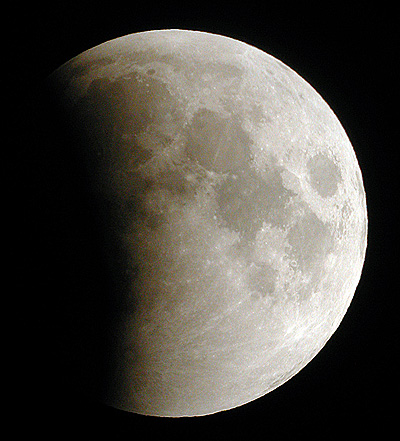
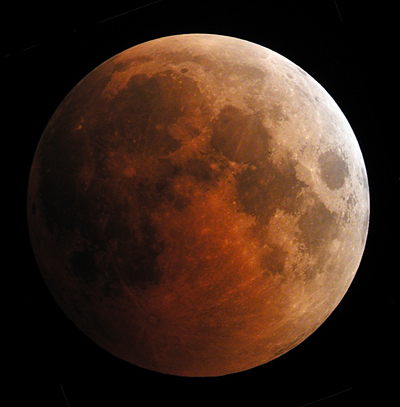
Here are some early shots of tonight's lunar eclipse, which is an unusually light one
(and thus very beautiful).
Celestron 5 telescope, 25-mm eyepiece, Nikon Coolpix 990 camera.
One of these will reportedly appear in some editions of tomorrow's
Atlanta Journal-Constitution.
I did my digital image processing just a few minutes after taking each picture,
then called the news desk and got an address to which to e-mail the picture.
I was apparently the first person to get a picture of the eclipse to the newspaper.
I encourage other amateur astronomers to do this. It's one of the best ways
to share your pictures with others.

|
 |
2004
October
26
|
Perna condita delenda est
This odd Latin motto has been circulating on the Internet.
Perna means "leg-bone" and condita means "established"
(as in the Roman calendar
ab urbe conditâ "from the founding of the city").
So why should an established leg-bone be deleted?
Well, perna can also mean "leg-bone meat," i.e., ham,
and condîta with a long i means "spiced."
And you recall Hormel's name for canned spiced ham.
So the motto means, "Spam must be eliminated!"
It was a nice puzzle, but I don't know who came up with it.

|
 |
2004
October
25
|
Lunar eclipse coming
There will be an eclipse of the Moon on Wednesday evening;
umbral phases from 9:14 p.m. to 12:54 a.m. EDT.
Details
here.
Answering the usual FAQs in advance:
- There is no danger to your eyes at any time. This is the Moon, not the Sun.
- It doesn't matter where you are. If you can see the Moon, you can see the eclipse.
- You can photograph it with any camera that has a long telephoto lens or zoom lens.
I've even used a camcorder. Exposures are hard to predict; try a variety of settings.
We've figured it out. The Smurfs grew up and are now known as Blue Man Group.

|
 |
2004
October
24
|
Lizards and "candid cameras"
 Our lizard friend from October 3 is now getting ready to hibernate
and has turned dark brown.
She'll simply crawl into a protected place and sleep all winter, emerging occasionally
on warm days.
Our lizard friend from October 3 is now getting ready to hibernate
and has turned dark brown.
She'll simply crawl into a protected place and sleep all winter, emerging occasionally
on warm days.
This afternoon I browsed through Volume 1 (1937) of
Popular Photography,
a magazine I've enjoyed reading (off and on) since the late 1960s.
It's interesting to watch how the magazine took shape.
First, the context.
What was new in 1937?
The biggest thing is that "candid cameras" (small handheld cameras) were becoming common.
Previously, all photographs - even news photos - had involved careful posing, often with
the camera on the tripod.
Suddenly it was possible for people to photograph whatever they saw.
And this led to a lot of cultural issues that we are experiencing again with camera cellphones.
People saw nothing wrong with taking pictures in the theatre,
or at people's private gatherings, and then selling them to the eager news media.
A lot of the legal and copyright issues had not yet been hammered out.
On points where the demands of the law (or simple etiquette) were clear,
they were often ignored.
To the magazine- and newspaper-reading public, "candid" pictures were a novelty.
There was a minor scandal when two photos caught President Roosevelt with an awkward
expression on his face, starting a rumor that he was seriously ill.
People were accustomed to carefully posed pictures, and they figured that if
a picture looked bad, there must be a serious reason.
The other novelty was color photography.
Kodachrome had just been introduced but had not yet established itself.
Studio color pictures were still taken on a three-plate camera, which used
beamsplitters to produce separate images for red, green, and blue.
Into this situation stepped Popular Photography.
At first they didn't have a good feel for what their audience was interested in.
Early on, they had a lot of articles about elaborate studio setups,
posing, makeup... and they figured we wanted to see lots of girls in bathing suits.
By November or December they had found themselves, with a good mix of photographic
technique and examples of good pictures that amateurs could actually take.
Along the way, they published good articles about Margaret Bourke-White,
Weegee Fellig, Alfred Eisenstaedt, and the operations of Life and
the Associated Press.
And as the film era draws to a close, they're still in business, reviewing the
latest digital equipment. Equipment reviews and tests predominate today, but
in 1937 there were none at all.
It was an obvious thing to do, but they weren't doing it.

|
 |
2004
October
23
|
A fortunate optical mistake
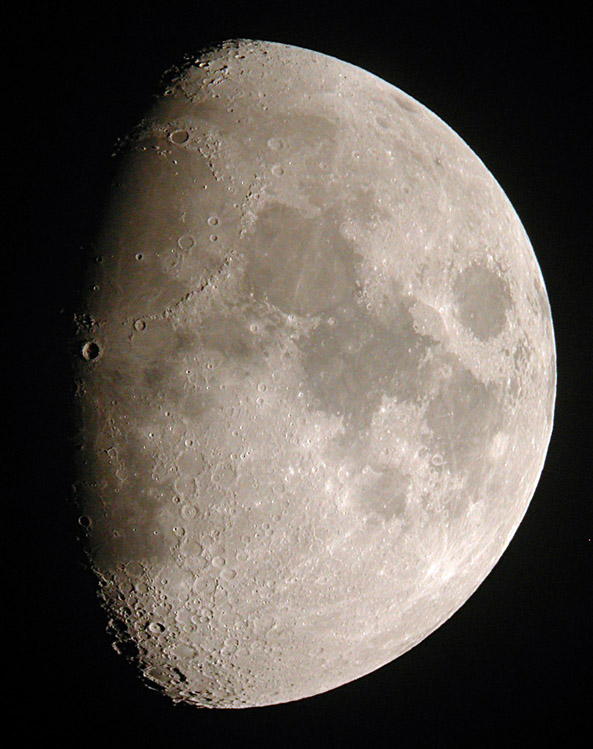
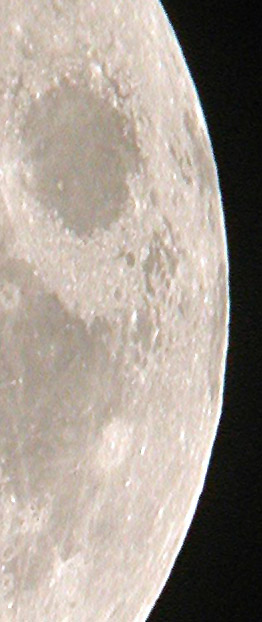
Yesterday evening I was photographing the Moon with my Celestron 5 telescope, a 32-mm eyepiece,
and my Nikon Coolpix 990 camera.
I was using the standard afocal technique, where the camera looks into the eyepiece.
In such situations the camera lens is supposed to be wide-open, at maximum aperture, in order
to take in the entire exit pupil (beam of light) coming out of the telescope.
Otherwise you don't use the full aperture of the telescope.
Well, in this case I had the Coolpix zoomed to 12.2 mm but only opened up to f/8.1.
That gave an aperture of about 1.5 mm.
And the telescope's exit pupil was 3.2 mm in diameter.
That means I was using my 5-inch telescope as a 2.5-inch.
Yet I got one of the sharpest pictures of the whole face of the moon that I've ever taken.
Apparently the smaller aperture overcame some optical aberrations.
Note the unusual state of lunar libration; we can see quite a bit past Mare Crisium,
as shown in the enlarged inset.

|
 |
2004
October
22
|
Miscellany
Amusing Hebrew suffix:
In Modern Hebrew there's a suffix -et that forms names of diseases.
For example, adam 'red' + -et gives ademet 'rubella';
kelev 'dog' + -et = kalevet 'rabies';
'yellow' + -et = 'jaundice'; and so forth.
And it turns out that niyar 'paper' + -et = nayeret 'paperwork'.
That's what I've been suffering from lately!
I owe this great insight to Joel Hoffman's new
book
about the history of Hebrew,
which contains a lot of information, entertainingly and nontechnically presented
(you don't have to know Hebrew, nor linguistics), but also puts forward some
novel ideas.
Hoffman argues that the Masoretes, who made the oldest surviving manuscript of the Bible
that includes the full set of vowels, were rather out of touch with the actual pronunciation of
Biblical Hebrew, and that some phenomena of Hebrew grammar
(such as the segolate nouns, melekh/malkh-)
were basically Masoretic inventions.
He also contends that the Divine Name (YHWH) was never pronounced, and was simply a string
of the "special" letters that the ancient Hebrews sometimes used to indicate vowel sounds.
(The writing of vowels was partly invented by the ancient Hebrews, although they had to wait
a couple of millennia for the Masoretes to finish the job.)
I tend to think, rather, that the Divine Name
is a form of the verb 'to be' (as in 'I am what I am' or 'I am the one who really exists').
Good online library:
Christian Classics Ethereal Library,
an amazing collection of classic Christian literature (from Augustine to Watchman Nee to G. K. Chesterton),
much of it available as audio as well as text.
There are even audio files of a lady reading the entire New Testament in the original Greek,
using the pronunciation common in West Coast seminaries, where omicron is a rounded low back vowel
(in real Koiné Greek it was rounded mid back, but she's following American tradition).
Lots of great reading, free!
Good pictures:
A nice photo gallery is maintained on line by Bret
Douglas.
Most if not all of the pictures were taken with new digital SLRs.
I particularly like
this
picture, and
this
one.
Bear in mind we're not dealing with a pretentious fine-art photographer;
this is just one man showing us some pictures he has taken,
some of which are, in my opinion, very good.

|
 |
2004
October
21
|
Civilized advertising?
Some of my web pages - not this one, and not the ones that promote my own products
and services - now carry Ads by Google
that are targeted to the content of the pages.
The ads are small and tasteful.
The advertisers pay Google, and Google pays me, when people click on them to view the ads.
What makes the whole thing very civilized is the following rule:
Google does not want people clicking on the ads unless they actually want to.
I'm explicitly forbidden to say things like,
"Please support me by clicking on the ads."
If I did that, the advertisers would have to pay for wasted clicks.
All other means of manipulating the system are also prohibited.
It's an advertising medium where
the viewer is in control.
Isn't that exactly what's right about the Internet - and
what's been wrong about TV all these years?
So far, the ads are bringing in more than $2 per day, and we haven't
even been through a weekend yet.
I installed them in order to get some income from my pathetically popular,
and totally non-income-producing,
NOPPP
page (the "No-Parts PIC Programmer").
I also put them on a few other "information only" web pages.

|
 |
2004
October
19-20
|
Department of Cryptic Names
Our Department of Drama is proposing to change its name to
Department of Theatre and Film Studies.
I think this is a bad move for two reasons.
First, they'll never settle on whether to spell it theater
or theatre. Both are correct, but only one can be its name.
Second, and more amusingly, film as a physical medium is almost
obsolete. Why enshrine it in a department's name now?
\begin{crotchety_old_geezer}
Actually, many parts of our university have names that are, in my opinion,
somewhat cryptic.
Who's ashamed of using words that actually describe what they refer to?
Below are how I'd rename some of them.
I'm conscious that I'm proposing to rename 2 units that I actually work for,
and also that many of these units have names that are traditional from one
university to another, even if cryptic to the outside world.
But here goes, anyhow.
| Current name |
My proposal |
Comments |
| Physical Plant |
Buildings and Grounds |
What was "physical plant" ever supposed to mean? |
| Human Resources |
Employment |
Late 1960s buzzword. |
| Enterprise Information Technology Systems |
Computer and Network Services |
We're not exactly an enterprise, and this unit doesn't have a monopoly on information. |
| Department of Classics |
Department of Ancient Languages |
Admittedly a slight change in meaning, but this isn't
the only department that studies literary classics.
And then there's classical music... |
| Department of Statistics |
Department of Statistical Computing |
To stop people from calling to ask how many students we had in 1953, and things like that. |
| Artificial Intelligence |
Cognitive Computing |
Or numerous alternatives; maybe even Cognitive Science.
Our intelligence is genuine; that of our machines, maybe not. |
But that's just the way I see it.
I do not think anything becomes nobler by being given a name people can't understand.
\end{crotchety_old_geezer}

|
 |
2004
October
18
|
Special bonus! October 18's entry uploaded on October 17!
PVC-pipe laptop stand


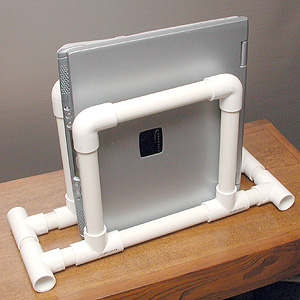
My latest folly, er, invention, is this gadget, which stands on the floor next
to my easy chair and holds my laptop computer (in either of 2 positions)
when I'm not using it.
Some information for people who want to replicate it:
It's made of 3/4-inch PVC pipe. The parts are:
8 pieces 7 1/2 inches long;
6 pieces 2 1/2 inches long;
4 elbows;
8 tees.
Total cost, about $8. Do the cutting carefully with a miter box or the like
(I used a sliding cutoff box on a table saw).
Assemble carefully, using a flat table top to help with alignment,
and use less than the normal amount of cement so you'll have plenty of
working time. (It doesn't have to hold water.)
After trying several solvents, I gave up on trying to remove the lettering
on the parts.
I may eventually paint it with
Krylon Fusion paint,
which is specially designed to adhere to plastic
(and, in my experience, actually does so).
The pictures were taken with my Nikon Coolpix 990 and an external Sunpak flash,
bounced off the ceiling.
Click here
for more about the flash technique.
For another design see November 1.

|
 |
2004
October
17
|
A bit more about digital SLRs
Further to yesterday's entry:
- The price difference between Nikon N70 and Canon Digital Rebel is mainly in the lens.
Each camera is sold bundled with a zoom lens.
Canon gives you a considerably cheaper one that is not as sharp at the corners of the field
at wide apertures.
[Note added October 29: I no longer believe this is the case.
Canon's lens, although small and light, is getting good reviews, and the same lens with a
different focusing motor is now bundled with the professional Canon EOS 20D. One widely
published review of this lens appears to have been based on a lens that was slightly defective
in some way, perhaps with a mispositioned element.]
Canon has started offering the Digital Rebel as body only, with a $100 rebate, to encourage
people to buy a better lens with it.
Unfortunately, the next step up, with Canon lenses, is a lot more expensive.
Fortunately, zoom lenses for Canon autofocus SLRs will fit it; anything that zooms
from 20 mm (or less) to 40 mm (or more) will do fine.
You could use a 28-mm wide-angle lens as a "normal" lens.
Because the CMOS sensor is smaller than a piece of 35-mm film, you need shorter-focal-length
lenses for the same field of view.
- The performance difference between N70 and Digital Rebel has to do mainly with
electroluminescence.
In very long exposures (like 5 minutes), the N70's sensor begins to pick up some
infrared light emitted by its own circuitry.
This affects only one corner of the picture.
I'm not sure if I'm going to participate, but I expect Christmas 2004 to be
digital SLR season big-time.
I saw Digital Rebels on sale at Sears; both Digital Rebel and N70 at Best Buy;
and so on.
They're everywhere.

|
 |
2004
October
16
|
Multiple topics today to make up for the recent shortage...
Kudos
 You read it here first: My graduate student Congzhou He, a linguist who came
from China to study computer science, has won this year's
James L. Carmon Scholarship
for creative use of computers in research.
The University will put out a press release later.
You read it here first: My graduate student Congzhou He, a linguist who came
from China to study computer science, has won this year's
James L. Carmon Scholarship
for creative use of computers in research.
The University will put out a press release later.
Congzhou has been part of the CASPR project since its inception.
She finished her M.S. in Artificial Intelligence last spring and is now doing a Ph.D.
in Computer Science.
Incidentally, the word kudos "honor" is Homeric Greek and is singular.
There's no such thing as "one kudo" [sic].
When Groucho Marx used the word that way, he was making a joke.
My election prediction
OK, folks, now it's time for me to unveil my prediction for the upcoming presidential
election. I predict that it will be a 50-50 split,
with one candidate garnering only slightly more
votes than the other. And I don't know which one that will be.
The previous election was a close split, too, and both sides seemed to ignore this fact.
During the dispute about the Florida ballots, each party talked as if it deserved complete
and unquestioned victory over the other side.
Folks, this isn't a football championship - it's an election.
If you ask the American people what they want,
and they reply, "We're split 50-50," you should listen.
Whether Bush or Kerry wins, he'll have to deal with the fact that about half the country
supported the other candidate.
6-megapixel astronomical CCD camera, $999 (?)
For years it has been axiomatic that astronomical CCD cameras have to be cooled thermoelectrically
in order to record images of faint objects.
Otherwise there is too much electrical leakage in the sensors.
That axiom no longer holds.
Three or four current-model digital SLRs, designed for general photography, work reasonably well
for deep-sky imaging by themselves.
They're not quite as good as the best astronomical CCDs, but they are very usable, and quite good
for the price.
The technique is to stack multiple exposures of perhaps 2 minutes each.
In exposures of this length, the automatic dark frame subtraction inside the camera
does a very good job of cleaning up the noise.
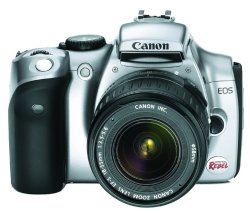 I haven't used any of these cameras myself, but based on what I've read, the best sensor
is in the Canon EOS Digital Rebel and
Canon EOS-10D.
This is actually a CMOS device, not a conventional CCD, and the price is right - only $999
(street price) for the Digital Rebel with a cheap zoom lens.
(You'll need to add a conventional telephoto lens or a T-adapter for coupling to a telescope.)
The EOS-10D is more ruggedly built and adds mirror lock.
See Oct. 17 entry for more about this.
I haven't used any of these cameras myself, but based on what I've read, the best sensor
is in the Canon EOS Digital Rebel and
Canon EOS-10D.
This is actually a CMOS device, not a conventional CCD, and the price is right - only $999
(street price) for the Digital Rebel with a cheap zoom lens.
(You'll need to add a conventional telephoto lens or a T-adapter for coupling to a telescope.)
The EOS-10D is more ruggedly built and adds mirror lock.
See Oct. 17 entry for more about this.
Nikon's D70
is almost as good; the sensor performance is inferior and the price is higher,
but if you have a lot invested in Nikon lenses, you might prefer it,
and it is arguably the best digital SLR for general photography.
The D100 has even better controls and overall design, in my opinion, but the CCD is said
to be inferior (it is older technology).
Some useful links:
If you like Nikons, stay tuned because their new
D2X
uses a Canon-like CMOS sensor.
It's a very expensive camera for professionals
(12 megapixels, $3200)
and I have not yet actually seen any tests of its performance in astrophotography.
How soon until Nikon deploys the same technology in an updated
D70 in order to outshoot Canon?
Meade is also marketing a
deep-sky imager
which is apparently a sensor similar to the current Nikon D70 (Sony HAD CCD) in a much smaller
size (0.25 megapixel) at a lower price ($300).

|
 |
2004
October
15
|
Economics of multiplayer games
Today I defer to Cathy, who is smarter than me, and has written a
very
interesting blog entry on the subject of economics in multiplayer computer games.

|
 |
2004
October
14
|
PCMCIA (PC Card) - A Bad Idea?
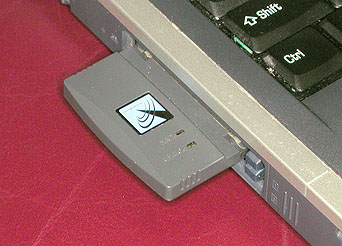 The PC Card slot in your laptop is a hidden peril.
The PC Card slot in your laptop is a hidden peril.
Within one week I've encountered 2 laptop computers that were damaged in an unusual way.
If you have a PC Card (PCMCIA) wireless network adapter that sticks out a couple
of centimeters, and it gets hit, it can act as a lever that breaks off the
PCMCIA connector internally.
That connector is on the motherboard and costs $1400 to fix.
And that's what happened to one of the laptops, fortunately an older one for which
the PC Card slot is not mission-critical.
Another laptop has one of its two PCMCIA sockets inoperative, and I strongly suspect
that essentially the same thing has happened, but with less total damage.
Admittedly, it's partly the fault of the wireless network adapters.
PC Cards were meant to fit entirely inside the computer, with tiny, thin
connectors to the outside world when necessary.
An increasing number of them, however, now protrude far enough to be at risk of damage.
The moral? Buy USB, not PC Card when you need a network adapter or other
laptop peripheral.

|
 |
2004
October
12-13
|
CGI in Prolog
[Notes added October 14.]
My examples of CGI scripting in Prolog (in this case SWI-Prolog) are again
on line here
[oops! corrected now].
The main one is called Binocular Wizard and is an expert system to help you choose binoculars.
The way they work is that
Internet Information Server (IIS) has been told that if a CGI file has a name ending
in .swi, it should be passed to the console-mode
SWI-Prolog interpreter
with additional command line arguments to make it start up and call a procedure named start.
(It might be better to compile the program to an executable
with GNU-Prolog or the like, but I didn't.)
You can view the program source code - both for Binocular Wizard and for a much
simpler example that just reproduces its input.
Although numerous software tools exist for web access to Prolog programs, I didn't use any of them.
A CGI script is just a web page that consists of a computer program rather than a text file.
The computer program runs and produces the web page contents as its output.
CGI scripts can receive input when they are called from other web pages with forms on them.
So I just programmed what I needed, the same as I would have done in C or whatever.
"A plan is not a litany of complaints."
- George W. Bush,
in tonight's presidential debate.
Worth remembering.
Back in the 1980 debates, Jimmy Carter pointed out that
when a difficult decision comes up, you
can't just follow the experts - "the experts will split 50-50" - and that's what makes it a
difficult decision.
So there have been at least 2 instances, in my lifetime, of intelligent things being said
by presidential candidates in debates.

|
 |
2004
October
8-11
|
Writing, but not here
An uneventful weekend, during which I made good on my promise not to write a blog entry every day.
I've been figuring out how to use external flash with my Nikon Coolpix (which is not well
documented by the manufacturer) and am writing up some notes
here.
Don't expect an entry tomorrow - I'll be out of town.

|
 |
2004
October
7
|
Babbage stops a home invasion
 I haven't said much about Babbage,
our dog since July, but
today he earned his badge as a
watchdog.
I haven't said much about Babbage,
our dog since July, but
today he earned his badge as a
watchdog.
Cathy and Sharon have the flu, and all of us were at home, sleeping rather late.
An exterminator's truck pulled up and Sharon groggily answered the doorbell.
Finding no one there, she pushed the door shut - or so she thought.
The exterminator was busy outside, and then she came in and started to spray
the interior of the house.
Babbage barked.
And well he should!
The exterminator was in the wrong house.
It wasn't our exterminator.
You should have seen the look on her face when I told her - truthfully - that I am
allergic to some insecticides.
Fortunately, not much of the house had been sprayed, and she left with profound apologies.
For that matter, I wish I had seen the look on her face when Babbage first
started barking.
He's small, but he can sound like the Hound of the Baskervilles!

|
 |
2004
October
6
|
Meet CASPR, my new research project
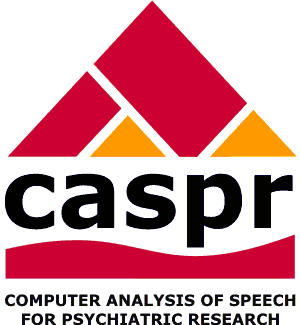 My new externally funded research project has received approval,
and for the next three years, I'll be doing nothing but research
(and a little teaching connected with the research).
No more playing "whack-a-mole" with computer viruses...
nor teaching the usual slate of courses.
My new externally funded research project has received approval,
and for the next three years, I'll be doing nothing but research
(and a little teaching connected with the research).
No more playing "whack-a-mole" with computer viruses...
nor teaching the usual slate of courses.
To the right is the project logo.
In due course the University will issue a press release about it.
Unfortunately, apart from that, I can't say much about the content
of the project.
It has a corporate sponsor and a nondisclosure agreement.
But as you can tell from the logo, it involves
using computers to measure abnormalities in the speech of
people suffering mental illness.
It's not often that a linguist gets to do anything that will
reduce the amount of suffering in the world, but I'm glad to be doing so.
I'm also glad to be participating in the trend to
define mental illness as impairment rather than oddness.
Half a century ago, you were mentally ill if your therapist
didn't like the way your mind worked.
Today, you're mentally ill if you can't function the way you used to,
or can't function the way people in your situation normally can.
The focus is on finding and correcting specific deficits.
By developing more specific measures of language
impairment, we'll make it easier to
tell whether a patient is getting better or worse, and this
will have a big payoff in research and clinical practice.
Many people graduate from college without ever realizing
where universities get a lot of their money.
A university is not just a school - it's also a research
institution, and it sells its research services to various
kinds of funding agencies.
The money from my contract will pay my salary plus another person's
and will put five people through graduate school.
And this is what I was busy arranging in England in July.

|
 |
2004
October
4-5
|
Miscellany
A very busy few days, but a large research contract has come through, and I'm looking forward
to three years of 100% research (no administration and very little teaching) in 2005-2007.
The astute reader will note that surprisingly little of my work life or my personal life shows up
in this Daily Notebook. Here I pretend to be much duller than I am!
Last night I saw Supernova 2004et
with my own eyes,
using an 8-inch telescope.
Oddly, I couldn't see the host galaxy. But the supernova was there, visible as
a faint, 13th-magnitude pinpoint.
The "et" in its name is just a consecutive designation; E.T. isn't phoning home...
Oops! Melody's kaleidoscope collection
was inadvertently left out when
we changed web hosts a few months ago.
Now the kaleidoscope pages are back.
Enjoy!
Happy birthday to Melody, whose age is of course 21+n, where n is a
suitably small integer.
The other day, she had the odd experience of first being mistaken for an undergraduate
(at a University function) and then being given the senior citizen discount
(at Arby's, by a young man who apparently offers it to everyone older than himself).
Ageless beauty!

|
 |
2004
October
3
|
Anolis carolinensis


Copyrighted images. Please contact me for higher-resolution scans
and for permission to republish them.
Lizards are normally very shy, but
this young female was willing to ham it up for my camera yesterday afternoon.
She's a green anole (Anolis carolinensis) or American chameleon,
native to Florida, Georgia, and the Carolinas.
Many people are not aware that this kind of lizard can change color from
brown to green.
She was in the process of turning green as I took the pictures, and you can
probably see a slight difference between them.

|
 |
2004
October
2
|
How to publish your own book
The Amazon system that I described yesterday is a boon to anybody who wants to sell a book,
all by themselves, in small quantities. Here, roughly, is what you do:
(1) Apply for a block of ISBNs (International Standard Book Numbers) at
www.isbn.org.
A block of ten costs only $19.95.
(2) Be sure to send in (to the same place) the particulars of each book you publish
when you assign one of the ISBNs to it.
(3) Also register with the Copyright Office (for copyright protection)
and (preferably) the Library of Congress (for cataloguing).
This is not expensive or difficult.
(4) Now that your book is in the databases,
you can sell it on Amazon Marketplace.
You will also get orders "out of the blue" from booksellers who have found it
in Books In Print and want a copy, wholesale.
You should give a wholesale discount of maybe 20%; maybe more on large orders.
(5) You don't even have to do the printing and selling yourself.
Do a Google search for "printing on demand" to learn about this
burgeoning industry.
Because books can be printed one at a time, nobody has to invest in a
print run of 1,000 or 10,000 the way they used to.
One publisher that caters for very small runs is CaféPress.
They will also print your artwork on almost anything - again, with a minimum order of just one,
and the ability to sell multiple copies easily through their site.
[Note added 2011: Lulu.com has established
itself as one of the best self-publishing companies for printed books and e-books. See their
advertisement below.]
(6) But your book still has to be typeset - that is, it has to be
prepared for printing, perfectly typed and laid out.
This is the only substantial "up front" cost other than just
writing the book.
If you're really good with a word processor, you can either do the typesetting
yourself, or get it so close that a professional doesn't have much more to do.
But be careful.
Amateur book publishers often omit obvious things (even page numbers!)
and come up with shoddy-looking designs.
If you want good typesetting, hire someone - such as
Covington Innovations.
[Note added 2011: Covington Innovations no longer does this,
but Lulu and other full-service companies do.]

|
 |
2004
October
1
|
Book sale
I'm using the Marketplace feature of
Amazon.com to sell a few books,
as I've done several times in the past.
It's simple and reliable.
You create an account, log in, and tell Amazon what books you're selling
(by ISBN), in what condition and at what price.
Amazon directs people to your listings when they search for those particular
books.
They use the ISBN (International Standard Book Number) system as a universal
catalog to bring together all listings for each book.
Amazon then collects the payment and sends it to you (less a commission)
and you send the book to the purchaser.
There is no cost unless you actually sell something.
You can use this method to sell one book or a thousand.
Here's what I'm selling this time:
-
Pinkster, ed., Latin Linguistics and Linguistic Theory: Proceedings of the First International Colloquium (1981)
-
Abramson and Rogers, Meta-Programming in Logic Programming (Logic Programming)
-
Shapiro, Algorithmic Program Debugging (ACM Distinguished Dissertation)
-
Burke and Foxley, Logic and Its Applications
-
Nie, Fuzzy-Neural Control: Principles, Algorithms and Applications
-
Martín Vide, ed., Mathematical and Computational Analysis of Natural Language: Selected Papers
-
Bunt, Discontinuous Constituency
-
Lieber, Deconstructing Morphology : Word Formation in Syntactic Theory
-
Lamarque, Concise Encyclopedia of Philosophy of Language
-
Vennemann, von Stechow, & Sternefeld, eds., Syntax Vol. 2: Ein internationales Handbuch zeitgenössischer Forschung
-
Parsons, Events in the Semantics of English: A Study in Subatomic Semantics
-
Reiter et al., eds., Building Natural Language Generation Systems
-
Levine, Studies in Contemporary Phrase Structure Grammar
-
Kamp & Reyle, From Discourse to Logic
-
Gabbay, ed., Handbook of Logic in Artificial Intelligence and Logic Programming: vol. 2: Deduction Methodologies
-
Gabbay, ed., Handbook of Logic in Artificial Intelligence and Logic Programming, vol. 3: Nonmonotonic Reasoning
-
Gabbay, ed., Handbook of Logic in Artificial Intelligence and Logic Programming: vol. 5, Logic Programming
-
Doets, From Logic to Logic Programming
-
Chomsky, On Nature and Language
-
Hawkins, Word Order Universals
-
Leffel & Bouchard, Views on Phrase Structure
-
Speas, Phrase Structure in Natural Language
Some of these are quite hard to find; in one or two cases nobody else is offering the same book for sale,
and in all cases, my asking price was the lowest on Amazon at the time I listed them.

|
 |
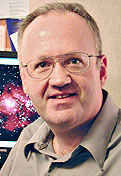

![]()


 Our lizard friend from
Our lizard friend from 




 You read it here first: My graduate student Congzhou He, a linguist who came
from China to study computer science, has won this year's
You read it here first: My graduate student Congzhou He, a linguist who came
from China to study computer science, has won this year's
 I haven't used any of these cameras myself, but based on what I've read, the best sensor
is in the
I haven't used any of these cameras myself, but based on what I've read, the best sensor
is in the  The PC Card slot in your laptop is a hidden peril.
The PC Card slot in your laptop is a hidden peril.
 I haven't said much about
I haven't said much about  My new externally funded research project has received approval,
and for the next three years, I'll be doing nothing but research
(and a little teaching connected with the research).
No more playing "whack-a-mole" with computer viruses...
nor teaching the usual slate of courses.
My new externally funded research project has received approval,
and for the next three years, I'll be doing nothing but research
(and a little teaching connected with the research).
No more playing "whack-a-mole" with computer viruses...
nor teaching the usual slate of courses.

